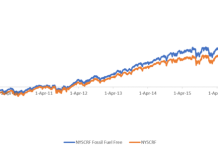by Tom Konrad, Ph.D.
A couple years ago, I began to see reports that coal supplies might not last the 200+ years we’ve all been lead to believe, so I wrote an article about what you could do to prepare your portfolio for Peak Coal.
Now two years have passed, and Peak Coal is undeniably 2 years closer. (Did you ever wonder why people who have been saying that we have 200 years of coal for 20 years aren’t now talking about 180 years of coal?) But more than being 2 years closer, the evidence continues to mount. Caltech Professor David Rutledge, has been spreading the peak coal word for most of the time since. I recommend the video of his 2007 lecture on the subject.
It’s great that the NY Times is asking "Is America Ready to Quit Coal?" but the real question may be "Will we have any choice?"
On February 12th, Clean Energy Action released a report on Powder River Basin coal supplies, based in part on a 2008 USGS report. The Powder River Basin matters because Western coal has been the only source of new coal production in the US for the last two decades. Appalachian and Interior coal production has been declining, despite mostly increasing prices, and uniformly increasing prices since 2003. Northern Appalachian coal production having peaked in the middle of the last century, while Interior coal production peaked at the start of this decade. When production declines in the face of rising prices, constraints other than economics must be coming into play. Future increases in production in these regions seems unlikely.

Of the top 6 coal producing states in the US, only Wyoming and Montana are still increasing production. West Virginia, Kentucky, Pennsylvania, and Texas all peaked in the 1900s. With existing Wyoming mines, which dominate current production, all having less than 20 years of reserves remaining, only Montana will remain… and we simply don’t know much about the geology to know how much can be recovered. Jim Hansen, author of the Master Resource Report, tells me that available rail supply lines out of Montana are likely to be another critical limiting factor on that state’s production.
The 2007 report from Energy Watch Group (which triggered my earlier article), David Rutledge, and Clean Energy Action all found that what we don’t know about our coal reserves far outweighs what we do know. What we do know should be very worrying to anyone who hopes that we might be able to replace our current coal fired electricity generation with any sort of "Clean Coal." Any attempt to sequester CO2 by pumping it underground or to the bottom of the sea would require considerably more energy than simply releasing it into the atmosphere, as we do now. That energy would come at a cost of less net energy from what will likely prove to be very limited coal supplies.
Peak Coal Accounting
If "Clean Coal" can be made to work, and we are able to replace part of our electricity supply with this technology, it seems increasingly unlikely that we will be able to supply as much electricity from coal 30 years from now as we do today. Coal plants are intended as 50 to 60 year investments, and part of the reason they are considered so "cheap" is that the construction costs are depreciated over more than half a century of payments. If, in reality, those construction costs must be paid over a shorter period, the effective cost of coal fired electricity will be considerably higher… even if the accounts do not yet show it.
Transitioning away from coal now makes sense both from an economic and climactic standpoint. If new coal plants will have shorter than expected useful lives simply because of the limited supply of coal, an honest accounting cannot spread construction costs 60 years, as has been done in the past. A shorter useful life means significantly raising the accounting cost of coal power per kWh, even before we place any price on carbon emissions or other environmental damage.
Carbon Capture and Storage
That is not to say that improving Carbon Capture and Sequestration technology will not be useful. Even without building new coal plants, we have a massive fleet of existing coal plants which are already spewing carbon into the atmosphere. According to a recent Inside Renewable Energy podcast, French utility EON puts current carbon capture technology costs about $40 per ton of CO2, and they hope to get the cost down to $20. This does not include the cost of pressurizing the gas and injecting it into some form of permanent storage. (Even permanent storage may not be so permanent.) Capturing CO2 for industrial uses can make economic sense today, and the economics will only get better when we begin to have reasonable prices for carbon emission. However, cleaning up the emissions of currently built fossil-fueled generation is not the same as investing new money in generation which we hope to clean up later.
We have the technologies today to begin this transition, and other promising technologies at least as near to development as "Clean Coal." Wind power is nearly as cheap as coal with current accounting. If we reassess the useful lives of prospective new coal plants, and put a price on carbon emissions, it will be much cheaper.
Building out the Smart Grid and additional Transmission capacity will allow us to integrate much more wind than skeptics currently think is possible. A recent report from the researchers at the Rocky Mountain Institute and the University of Colorado Boulder found that optimized diversified portfolios in the Midwest of wind and solar generation were 55% more reliable (measured by the variability of output) than the average individual site used in the study. For large scale baseload and dispatchable generation, Concentrating Solar Power needs only continued price improvement which will come from mass deployment, and a more robust national grid. For large-scale clean baseload power anywhere in the US, Enhanced Geothermal Systems are likely to be easier and cheaper to develop than "Clean Coal."
All of these are the right investments for the country, but they are also likely to be good moves for investors. We may still have 30 years before coal production in the US peaks. The stock market reaction will not wait until the actual p
eak… the stock market reaction will happen when sufficiently many investors realize it’s coming.
How many more reports will that take, I wonder?
DISCLAIMER: The information and trades provided here and in the comments are for informational purposes only and are not a solicitation to buy or sell any of these securities. Investing involves substantial risk and you should evaluate your own risk levels before you make any investment. Past results are not an indication of future performance. Please take the time to read the full disclaimer here.







My small great lakes region city-owned utility is planning to invest in an expansion of our current coal power plant.
This article can help a group of us who are united to fight it. Thanks for your clear-headed and long-term look at the subject.
You’re welcome. I’ve asked a friend who spends a lot of time fighting coal plants if she can leave you a commetn or send you an email with some more useful resources.
Hello D Lane: please write to catalyst@actionpa.org to ask about the no new coal plants listserv that’s helped many individuals. There are articles about the listserv on http://www.grist.org as well as the excellent website http://www.climateprogress.org
Your utility’s status as a municipal utility should mean that you can have input into decisions the utility makes on behalf of its citizens. Hopefully this is providing an opening for citizen involvement.
The Sierra Club is also working hard on many local campaigns for clean energy.
Thank you for your efforts!
Thanks! The Sierra Club is active in our fight and recently the governor has shown support. But locally the expansion supporters are very strong. I will inquire about the listserv.
I do agree that this nation must be forward thinking in regards to the the next energy feedstock after coal (i.e. methane and hydrogen). But in terms of available coal reserves it is critical that people understand the difference between what is a demonstrated reserve base and what are proven reserves. As the majority of coal deposits in the Powder River Basin are federally owned and must be leased prior to mining, companies will typically only hold between 10 and 20 years worth of proven reserves on the book. As these reserves are depleted additional reserves are leased. In point of fact the demonstrated reserve base in this basin is enough to sustain annual production levels of 450 million tons for at least another 130 years.
Nick wrote:
“As these reserves are depleted additional reserves are leased. ”
You make it sound so easy…